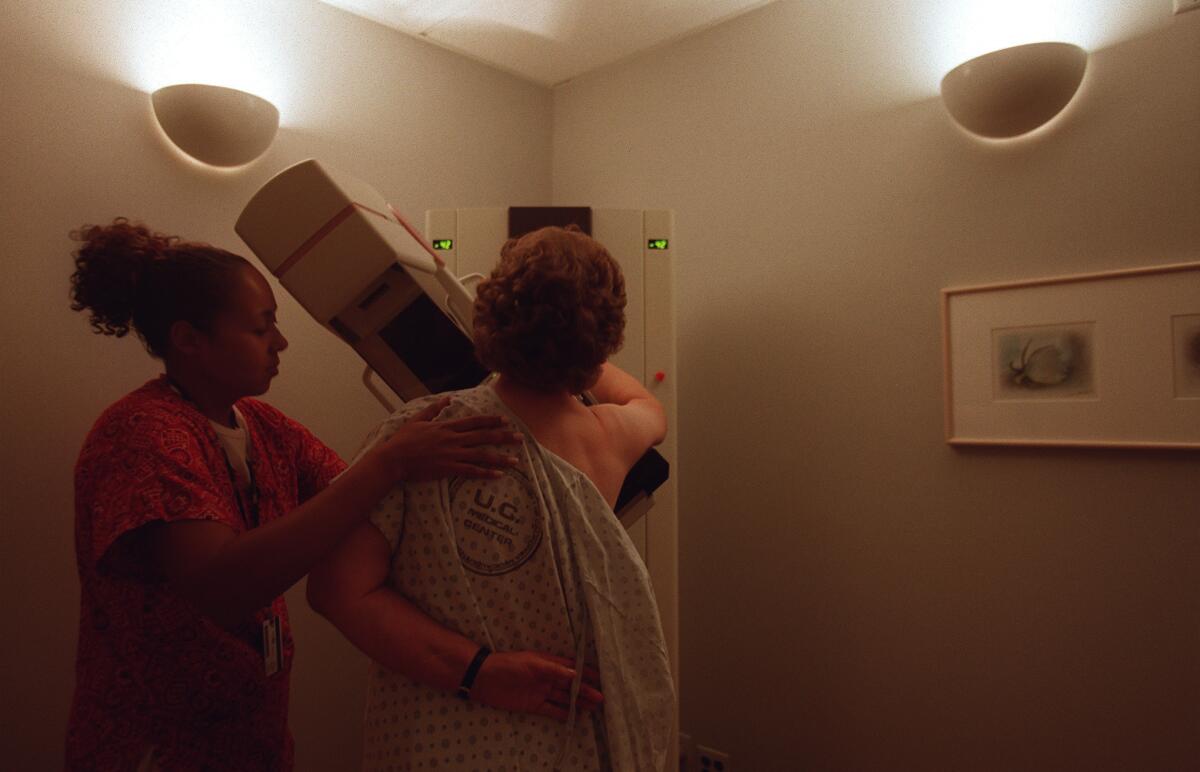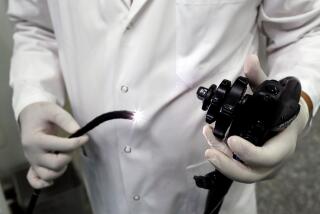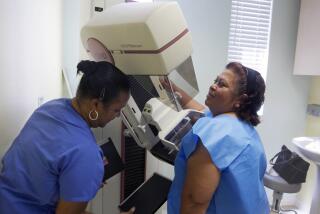Better treatment for breast cancer hasn’t boosted the benefit of mammograms, study says

Deaths from breast cancer have fallen since screening mammography has become widespread, but a study that accompanies new guidelines shows that better treatments are responsible for most of that reduction.
- Share via
The goal of cancer screening is to reduce the number of cancer deaths by finding tumors when they are still small and, presumably, easier to treat.
But a new study finds that in the case of breast cancer, improvements in treatment have barely changed the benefit of using mammograms as a screening tool.
The study, published Monday in Annals of Internal Medicine, explains that the value of early detection depends in part on the effectiveness of treatment. To understand the nature of that link, the team from the University of Washington and the Fred Hutchinson Cancer Research Center in Seattle created a series of virtual clinical trials.
Each of these trials examined a hypothetical group of 100,000 American women, all age 50. About half of them were randomly assigned to get mammograms to check for signs of breast cancer, and the rest were not.
See the most-read stories in Science this hour >>
Some of these virtual trials were imagined to occur in 1975, shortly before mammograms were routinely used to screen for breast cancer; some took place in 1999, after combination chemotherapy and hormone therapy came on the scene; and some took place in 2015, to reflect the latest medical knowledge and treatments. Each trial used cancer prevalence and survival statistics from its era.
In the first round of trials, the researchers assumed that screening mammograms would reduce the incidence of advanced breast cancer by 15%. That was the median benefit seen among eight real-life clinical trials.
After building computer models to run these virtual clinical trials, the researchers compared the risk of dying of breast cancer for women who got mammograms and women who didn’t.
In all three time periods, the women in the screening group were diagnosed with more early-stage cancers and fewer advanced cancers than the women in the unscreened control group. As a result, the women who were diagnosed after getting mammograms were eligible for different kinds of treatments than the women who didn’t get the tests.
Also in all three time periods, the women who got mammograms were less likely to die of breast cancer over the next 10 years than the women who didn’t. In 1975 and 1999, the relative risk of breast cancer death fell by 9% among women who were screened, and in 2015 it fell by 10%.
When it came to the absolute risk of dying of breast cancer, the researchers found that screening programs in 1975 reduced the number of breast cancer deaths by 4 for every 10,000 women. By 2015, they averted 3 breast cancer deaths per 10,000 women.
The consistency of those numbers was a sign that better treatments over 40 years did not enhance the value of screening, the researchers wrote.
However, when the researchers focused on the breast cancer mortality rate among unscreened women, they found that the risk of death was 40% lower in 2015 than it was in 1975. Since none of those women got screening mammograms, the lower death rate had to be because of better treatments over that time, the researchers wrote.
If that sounds like a contradiction, think of it this way: If better treatments were focused primarily on patients with early-stage breast cancer, then using mammograms to diagnose women sooner would make a huge difference. However, if improvements in treatment were mainly focused on patients with more advanced cancer, there would be less to gain by finding cancers early.
The team then conducted additional virtual trials under different virtual conditions. For instance, when they assumed that screening reduced the incidence of advanced breast cancer by 25% or 50% instead of 15%, more lives were saved by screening but the relative benefit of screening barely changed over time.
When the hypothetical women were tracked for 25 years instead of just 10, a pattern became clear: As breast cancer treatment got better, the number of women saved by screening got smaller. And that means that more women needed to be screened in order to prevent each additional death, the researchers wrote.
Follow me on Twitter @LATkarenkaplan and “like” Los Angeles Times Science & Health on Facebook.







